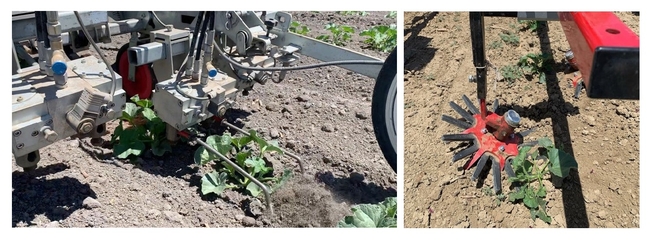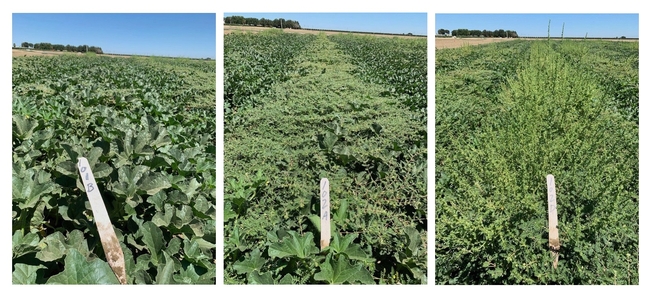In melons, as with many annual crops, weeds that emerge in the plant row are the most difficult and costly to remove. There are only a few registered herbicides for CA melon production, and efficacy can be marginal depending on weed species and method of incorporation. As a result, mechanical cultivation followed by hand weeding are the main methods of weed management.
Technology may be able to help. Automated weeders, or robotic weeders, use cameras and computers to distinguish crops from weeds. They are equipped with either spray nozzles, lasers, or cultivators to remove weeds within the crop row. Research by UC Davis weed scientist Steve Fennimore has shown that automated weeders reduced labor use in lettuce production by an average of 38-45% without reducing yield. Another alternative is the finger weeder, a simple mechanical cultivator capable of removing weeds from the plant row. The system uses interlocking rubber fingers to remove small weeds in the plant row once transplants are established. In studies done on the California coast by UCCE Advisor Richard Smith, finger weeders reduced hand weeding by 45% over standard cultivation in crops like lettuce and leeks.
Automated cultivators, however, have their limitations. They work better when there is clear size difference between the crop and weeds, when weed pressure is not overwhelming, and when the weeds are small. In-row plant spacing is important for the cultivators, as there needs to be enough space between crop plants for the blades to move in and out. And finger weeders are effective only if the weeds are very small, potentially limiting their use to very short periods during the cropping season.
Melons, however, should work well for automated weeders, as they are widely spaced down the row (18” to 24”) and finger weeders, since they have a deep taproot that strongly anchors them in the bed.
In 2022, I conducted a trial at the UC West Side Research and Education Center evaluating finger weeders and the Robovator automated weeder on weed control and crop safety in drip irrigated cantaloupes. These treatments were also compared to Prefar, Sandea, and Curbit herbicides. Herbicide treatments were Prefar (bensulide) 6 qts/A PPI, Sandea (halosulfuron) 1 oz/A 14 days POST, Curbit (ethalfluralin) at 4 pts/A 14 days POST, mechanical cultivation using finger weeders 14 days POST, mechanical cultivation using automatic cultivator (Robovator) 14 days POST, and an untreated control.
The finger weeder was operated at 3.5 mph, while the Robovator worked at 1.8 mph. The Robovator used standard 5” blades set to leave a 2” buffer zone around each plant at a depth of about 1” below the soil surface. Using a camera guidance system and a wheel to provide information on forward speed, the blades open around the plants to prevent injury; the finger weeder used Steketee “medium” 14-inch fingers with a slight overlap (Figure 1). The outside of the bed was cultivated using standard sweeps and lillistons at 3 and 5 weeks after transplanting.

Crop injury was observed in one row from the robotic cultivator and in the treatments that received post-emergence applications of Sandea herbicide. Both cultivators significantly reduced in-row weeds as compared to no cultivation at 2 and 4 weeks after treatment, however, weed pressure was equivalent by the end of the season. Nonetheless, hand weeding costs were reduced $37 - $54 per acre for the Robovator and finger weeder, respectively. This is about 20% savings as compared to the uncultivated control.
Herbicides, especially Sandea, had far greater impact on weed control than cultivation at this location. The Sandea herbicide treatment had significantly better weed control as compared to all others, over 90% at all evaluation dates (Figure 2). As a result, hand weeding costs were lowest for this treatment, reduced over $100 per acre (45% compared to untreated), and fruit yield was greatest at 1306 boxes/A.\
While the two cultivators evaluated in this trial did not reduce hand weeding costs as much as hoped, they nonetheless performed very well at the time of use. Puncture vine and redroot pigweed were the dominant weeds at this location, and emergence after cultivation reduced the benefit of these treatments. Very similar to the results of Fennimore and Smith in cool season crops, the results of this trial show that robotic weeders and finger weeders can help manage in-row weeds in melons and significantly reduce the amount of time needed to hand weed the crop. These savings were further improved when used in conjunction with the registered herbicide halosulfuron (Sandea).
This project was supported by the CA Melon Research Board.
Scott Stoddard is the UC Cooperative Extension County Director for Merced county and the Vegetable Crops and Soils Advisor in Merced and Madera counties (2145 Wardrobe Ave., Merced, CA 95341, csstoddard@ucanr.edu)